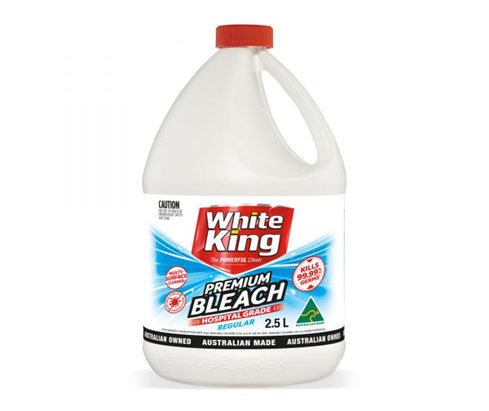cip2
Date and time request received: 21 March @ 1500 Version 1 3/3/21
(i) Chemical name
Sodium hypochlorite NaOCl <10%
Sodium hydroxide NaOH 1-5%
(ii) Chemical formula
NaOCl and NaOH
(iii) Other common/possible names for substance
Bleach, Household bleach
(iv) Trade Name(s) of products containing this substance (this list is not exhaustive)
White King Premium Bleach
(v) Photograph of product (if available)

(vi) Appearance/Colour/Odour
a) Clear liquid
b) Yellow
c) Characteristic odour of bleach
(viii) First Aid
Ingestion:
Do not induce vomiting. Immediately remove product from the mouth and wash out mouth with plenty of water. Obtain immediate medical attention.
Eye:
Immediately hold the eyes open and wash with fresh running water. Take care not to rinse contaminated water into nonaffected eye. Remove contact lenses, if present and safe to do so. Ensure complete irrigation of the eye by keeping the eyelids apart and away from the eye and moving the eyelids by occasionally lifting the upper and lower lids. Continue flushing until advised to stop by the Poisons Information Centre or a doctor, or at least 15 minutes. Obtain immediate medical attention.
Skin:
Remove contaminated clothing and wash skin thoroughly with soap and running water. Ensure contaminated clothing is washed before re-use, or discard. If symptoms develop, seek medical attention.
Inhalation:
Remove from source of exposure. Ensure airways are clear and have qualified person give oxygen through a face mask if breathing is difficult. If symptoms develop, seek medical attention.
(ix) Labelling
The product label must contain the “signal heading” Caution. This product also contains the following safety headings: Keep out of reach of children and
Read safety directions.
The Safety Data Sheet (SDS) mentions the “signal word”
“Danger”.
Company email for further information:
enquiries@pental.com.au
(x) Recommended Storage
The product is stable under normal ambient conditions of temperature and pressure. Store at room temperature in a cool, dry, well ventilated area, away from direct sunlight and moisture,. Do not store near strong oxidising agents (e.g. hydrogen peroxide H2O2, oxygen O2 ) or strong acids (e.g. hydrochloric or sulfuric).
Do not store in direct sunlight or where product can heat up.
Ensure product is securely sealed when not in use and stored away from possible physical damage (e.g. sharp objects which can puncture container.
(xi) Toxicity Include “toxicity bar or traffic light” here
Sodium hypochlorite itself may be toxic if ingested, or by dermal or ocular exposure. ... Sodium hypochlorite is corrosive and may irritate the skin or cause burning, pain, inflammation and blisters. Ocular exposure can cause irritation, pain, production of tears and sensitivity to light.
(xii) Recommended Personal Protective Equipment (PPE) if handling substance
It is recommended that people using this product “wear protective gloves, protective clothing, eye and face protection”, although in most household applications most users seem to only wear gloves, if any PPE at all.
Hazardous reactions and Breakdown products (decomposition):
The product will react with acids (e.g. hydrochloric or sulfuric) to produce chlorine gas which is extremely toxic.
Conditions To Avoid: Sparks, flames and other ignition sources. Direct sunlight and heat.
Thermal decomposition may result in the release of toxic and/or irritating fumes, including oxides of carbon and sulfur
(xii) Poisons information (if substance is s Scheduled poison)
S5 , that is, a Schedule 5 poison The label must contain the signal heading” Caution. Caution – Substances with a low potential for causing harm, the extent of which can be reduced through the use of appropriate packaging with simple warnings and safety directions on the label.
(xiii) Metabolism of substance in the body (2-3 brief, simple sentences and a relevant reference article).
“Mechanisms of toxicity: Hypochlorite's potential to cause toxicity is related to its oxidizing capacity and the pH of the solution. Toxicity arises from its corrosive activity upon contact with mucous membranes and skin.” These statements taken from Review Article referenced below:
Review article:
Clin Toxicol (Phila). 2019 May;57(5):303-311.
doi: 10.1080/15563650.2018.1543889. Epub 2019 Jan 28.
The clinical toxicology of sodium hypochlorite
Robin J Slaughter 1, Martin Watts 1 2, J Allister Vale 3, Jacob R Grieve 4, Leo J Schep 1
PMID: 3068945 DOI: 10.1080/15563650.2018.1543889
(xiv) Excretion of chemical substance or metabolites (2-3 brief, simple sentences and a relevant reference article).
Refer to comments above in (xiii)
(xv) Long term effects of exposure to chemical substance (2-3 brief, simple sentences and a relevant reference article)
Household bleach is very irritating and corrosive to the skin, lungs, and eyes. As well, it has been known to burn human tissue internally or externally. On top of this- it may cause skin rash, extreme headaches, migraines, muscle weakness, abdominal discomfort, oesophageal perforation, nausea and vomiting.
Reference article:
NDT Plus. 2011 Aug; 4(4): 231–235.
Published online 2011 Apr 7. doi: 10.1093/ndtplus/sfr053
PMCID: PMC4421444
PMID: 25949487
Spectrum of sodium hypochlorite toxicity in man—also a
concern for nephrologists
Brandon Peck,1 Biruh Workeneh,1,2 Huseyin Kadikoy,1 Samir J. Patel,3 and Abd Abdellatif
(xvi) Recommended treatment for addiction (if applicable).(2-3 brief, simple sentences and a relevant reference article).
Addiction to household bleach is very rare, although an article published recently discusses an usual case study:
Reference article:
Brazilian Journal of Psychiatry
Print version ISSN 1516-4446On-line version ISSN 1809-452X
Rev. Bras. Psiquiatr. vol.39 no.2 São Paulo Apr./June 2017
https://doi.org/10.1590/1516-4446-2016-2036
LETTERS TO THE EDITORS
